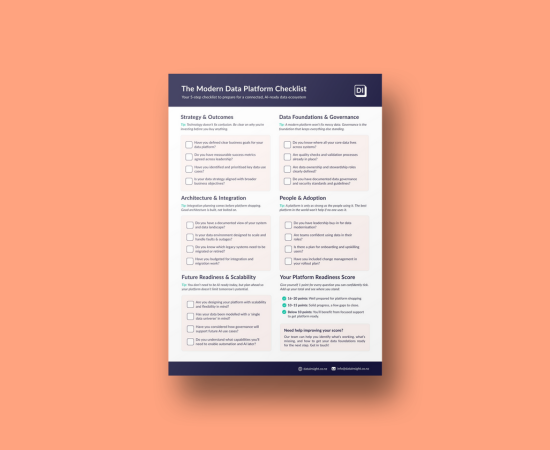Let’s skip the fluffy intro about how AI is either going to turn the world into a magical fairyland or bring about the robot apocalypse.
You’ve heard it all before. What nobody’s talking about, the elephant in the room, is this:
How do you actually get a real return on your AI investment?
Here’s an alarming stat:
IBM found that only 1 in 4 AI projects deliver the ROI they were supposed to. That’s globally.
In New Zealand? It’s even tougher. Returns are lower, the tech deficit is higher, and the skills needed to deliver real impact are hard to come by. The result? Most organisations tick the “copilot enabled” box and call it job done.
But this isn’t enough. New Zealand is falling behind.
AI is a value multiplier. It can greatly improve your team’s productivity and the quality of your products and services to clients. But we’ve got a skills gap the size of the Cook Strait, we’re running outdated tech, and our ways of working are based on the old world.
The Hard Truth About AI ROI in New Zealand
Let’s talk about the real blockers.
The stuff that kills ROI.
1. Your Team Doesn’t Know What the Heck to Do With AI
How do you expect your people to adopt and apply AI in away that drives results if you haven’t trained them? This technology is new. The pace of change is frightening.
And yet, most organisations are still hoping their people will just “figure it out.”
That’s not a strategy.
Just because you give someone a hammer doesn’t mean they can build a house. Your people need to know laws, governance, best practices, have access to data, guidance on use, ways of working that ensure results are what you expect, and alignment on what it is you’re even doing.
We’ve talked before about the current AI skills gap in New Zealand, and it’s really holding us back.
AI and data literacy needs to become a business-wide priority.
And it needs to start at the top. Boards and executive teams must take the time to understand what’s possible, what’s required to implement it, and where the risks lie.
You can’t lead what you don’t understand.
Top Tip: Train your people first. Don’t expect them to figure it out. Start with education, and make sure leaders are part of the learning.
2. You’re Starting With the Tool, Not the Target
AI is a solution looking for a problem.
Without clear objectives, it is easy to waste tons of money on AI initiatives that don’t move you forward or opt for on-demand AI tools that only give you small incremental time savings.
So, ask yourself:
- What are we trying to achieve?
- What is your organisation’s competitive edge?
- What’s costing us time, money, or customers?
- Where are we bleeding efficiency that the organisation values?
Top Tip: Start with a clear business problem. Define what success looks like before choosing the technology.
3. Your Processes Are Unclear
AI won’t fix broken processes. It’ll just automate the chaos.
Take customer onboarding, for example. If five different teams are touching the same process, emails are flying everywhere, and no one owns the outcome, AI isn’t your answer.
You don’t need automation. You need a rethink. End to end.
Only once the process is clear should you decide what’s actually worth automating.
Case in point: Klarna
Klarna, the fintech out of Sweden, made headlines when they replaced 700 customer support staff with AI. “Look at us,” they said.
“We’re handling hundreds of thousands of calls with no humans.”
But nobody asked the obvious question.
Why did they have that many support calls in the first place?
Maybe the issue wasn’t headcount. Maybe it was a broken product, clunky UX, or a confusing customer journey.
Eventually, they had to roll back a lot of that shiny AI. The result? Billions wiped off their valuation.
The lesson: Don’t slap AI on top of a broken experience. Fix the root cause first.
Top Tip: Rethink before you automate. If the process sucks, AI won’t save it. It will just speed it up.
4. Your Structure Might Be Killing Your AI ROI
Even when the technology works, the business might not.
We recently helped a large New Zealand company deploy AI agents into their ordering process.
On paper, it was a success. The agents saved each salesperson a number of hours a day. The business case was solid. The ROI was clear.
But there was a catch. Their organisational structure wouldn’t allow them to capture the value.
Why?
Because the team was distributed and siloed. The tech was great. The process was streamlined. But the savings couldn’t be fully realised without changing how the company operated, and that wasn’t easy to fix.
AI doesn’t respect silos. Its impact cuts across sales, ops, marketing, inventory, and customer service. If your structure can’t support that kind of integration, you’ll never unlock its full value.
Top Tip: Treat AI as part of your bigger transformation, not a standalone tool. To get real benefits, you need to align AI with your data, ways of working, organisational structure, and strategy.
5. Your Data and Legacy Systems Suck
Everyone is chasing the AI dream. But the catch is, the gold is in your data — and most of it is stuck together with bubble gum.
Take something as simple as personalisation. AI can recommend the right product, send the right message, or trigger the right next step.
But it needs rich, connected, trustworthy customer data to do it.
Most companies don’t have this. Their data is siloed, messy, can’t be trusted, or is inaccessible.
Worse still, many AI initiatives rely on manual workarounds or individual experts to stitch it all together. This makes the whole thing fragile, unscalable, and expensive.
Now, this doesn’t mean you need perfect data to start using AI. You don’t.
But if you want real, scalable ROI, you need to be building your data foundations, because AI is only as good as the data you feed it. (garbage in = garbage out!)
Top Tip: AI and automation can actually help clean up your data. These use cases may not be flashy, but they lay the groundwork for everything that follows.
So, why is AI ROI So Hard?
It’s not because of the technology. That part is easy.
It’s hard because:
- The pace of change is outstripping leadership understanding
- Too many start with the tool instead of the problem
- Most organisations don’t have a clear view of their own processes
- The siloed structures of organisations block cross-functional impact
- Data and tech foundations are weak
- There’s no change to ways of working or structure alongside the AI
If You Want Real ROI from AI, Get Ready to Rethink Everything
It takes bold thinking, deep change, and a willingness to challenge how your business actually works.
"New Zealand Inc" needs to catch up — quickly.
The opportunity is massive, but only for those willing to do the hard stuff.
.png)








.png)